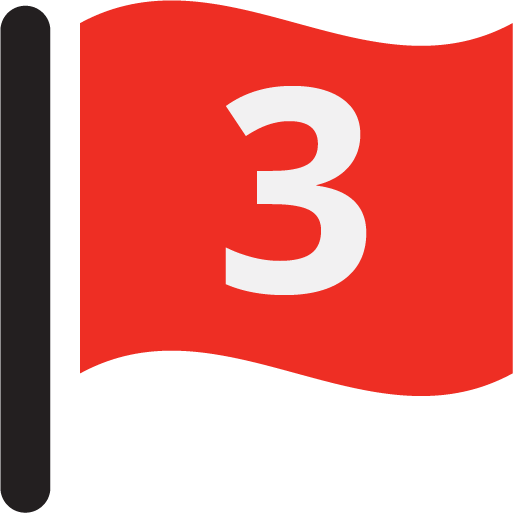We have developed our rating system to make it easy to understand a company’s financial health.
 GOLD
GOLDThese companies are the healthiest (the least likely to go insolvent) and are rated as the top 15-18% of all companies that are of similar size.
These companies have only the strongest, key financial ratios, show little signs of known insolvency indicators, and have an excellent history of filing accounts and compliance on time. They have healthy all-round financials and the chance of a gold company failing is less than 0.1%, open credit is recommended.
 SILVER
SILVERAround the next 28% of companies in its size band, when considering the likelihood of failure. These companies still have strong financial ratios but may have slightly higher gearing or lower liquidity, efficiency or profitability ratios than ideal. These companies are still very unlikely to fail,(0.3%), but are less financially stable than gold companies and more likely to move to a different rating. If the general trend is not upward, declines will be modest, and there won’t be any significant legal notices. Open credit is recommended.
 BRONZE
BRONZEThe next 39-40% of companies, within a company’s size band, and scorecard, when considering the likelihood of failure. These companies are the lowest-scored companies that have passed our scorecard and make up the majority of scored companies in the system. These companies will still have a low chance of failure, 0.7%, but are not as financially stable as silver and are much more likely to drop to a lower rating.
They may have a combination of sub-optimal ratios, leading to a lower score, while still being stable enough to warrant a pass on the scorecard. This may be a combination of mixed financial ratios – gearing, efficiency, liquidity and profitability. Typically, some of the financial characteristics will meet the threshold requirements while others will not (more so than silver) leading to a lower score. These companies are in acceptable health and nothing significantly detrimental is known, though there may be some history of legal notices but are considered to be a fair trade risk and recommended for open credit.
 ONE RED FLAG
ONE RED FLAGThe companies in 1 red flag have a higher chance of failure than the national average (1%) and are among the weakest 14% of all companies in the rating system. These companies do not pass the scorecard and do not meet the minimum threshold requirements to attain high scores in the majority of the financial fields. Typically if these companies are not failing, and are remaining at a 1 red flag rating for a long time this is due to connected parties giving unsecured loans, leading to the business being well-funded and unlikely to fail despite the poor financial performance. These loans will typically make the balance sheet of these companies appear even worse while allowing the company to avoid insolvency and continue trading. There may be evidence of recent or significant legal notices and the risk is elevated, so suppliers should seek suitable assurances or guarantees.
 TWO RED FLAGS
TWO RED FLAGSThe companies in 2 red flags have a much higher chance of failure and are among the weakest 20% of all companies, but are not in as critical a position as 3rf. These companies do not pass the scorecard and do not meet the minimum threshold requirements to attain high scores in the majority of the financial fields. There will likely be evidence of recent or significant legal notices and is very high risk.
 THREE RED FLAGS
THREE RED FLAGSThe companies with 3 red flags are in the bottom 1% of the companies that fail the scorecard. These companies do not pass the scorecard and do not meet the minimum threshold requirements to attain high scores in the majority, if not all, of the financial fields. There will likely be evidence of recent or significant legal notices and will have a deteriorating financial position with sub-optimal gearing and liquidity. They may also have recent county court judgments of materially significant value and are overall at a very high risk of going insolvent.
 PROVISIONAL SILVER
PROVISIONAL SILVERThese ratings (Silver, Bronze, 1rf, 2rf) are when a company has only one set of filed accounts. These companies go through our provisional scorecards and get a provisional rating of one of the four ratings listed above. This a ‘soft’ rating and will remain until a second set of accounts is filed – at which point the rating will become a ‘firm rating’ and go through the scorecards as normal.
 PROVISIONAL BRONZE
PROVISIONAL BRONZEThese ratings (Silver, Bronze, 1rf, 2rf) are when a company has only one set of filed accounts. These companies go through our provisional scorecards and get a provisional rating of one of the four ratings listed above. This a ‘soft’ rating and will remain until a second set of accounts is filed – at which point the rating will become a ‘firm rating’ and go through the scorecards as normal.
 PROVISIONAL ONE RED FLAG
PROVISIONAL ONE RED FLAGThese ratings (Silver, Bronze, 1rf, 2rf) are when a company has only one set of filed accounts. These companies go through our provisional scorecards and get a provisional rating of one of the four ratings listed above. This a ‘soft’ rating and will remain until a second set of accounts is filed – at which point the rating will become a ‘firm rating’ and go through the scorecards as normal.
 PROVISIONAL TWO RED FLAGS
PROVISIONAL TWO RED FLAGSThese ratings (Silver, Bronze, 1rf, 2rf) are when a company has only one set of filed accounts. These companies go through our provisional scorecards and get a provisional rating of one of the four ratings listed above. This a ‘soft’ rating and will remain until a second set of accounts is filed – at which point the rating will become a ‘firm rating’ and go through the scorecards as normal.
 NEWLY INCORPORATED
NEWLY INCORPORATEDThese companies are newly incorporated and have not filed accounts, as such we do not have the data required to score them, and they remain in this holding rating until the point at which they have the information necessary to score.
 NOT TRADING
NOT TRADINGThis simply indicates that according to information filed at Companies House the company had a non-trading status. Should credit be sought in the name of the company care should be taken and a full disclosure sought.
 PRE INSOLVENT
PRE INSOLVENTThese companies fail with 28 days 98% of the time. This rating is a pre-cursor to insolvency and as such we would not recommend credit in any circumstance.
 INSOLVENT
INSOLVENTThe company has undergone some form of Insolvency; please check the full record. All credit transactions should be stopped.
 STRIKE OFF
STRIKE OFFA Striking-Off action at Companies House has been registered against the company or limited liability partnership. This can be voluntary or instigated by Companies House. The full record should be reviewed and if credit is sought then care should be taken and a full disclosure requested to ascertain the current trading status.
 DISSOLVED
DISSOLVEDThis company has been dissolved by Companies House and no longer exists. Should you be trading with a company in this name you should 1) review your situation immediately, 2) obtain a full disclosure of affairs before entering into any further transactions and 3) ensure you are trading with the correct company going forward. Company has undergone some form of Insolvency; please check the full record. All credit transactions should be stopped.
 INACTIVE
INACTIVE
Though the legal status indicates this company is active, the lack of up-to-date accounts or lack of significant assets leads us to believe this company is not active
If you have any further questions, please reach out to our Support Team via Contact Us.
